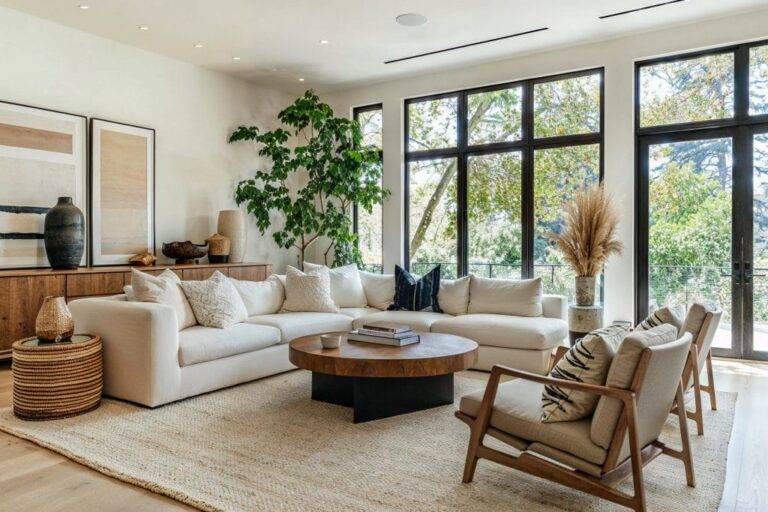When it comes to home décor, the terms “aesthetic” and “style” are often used interchangeably. However, they represent distinct concepts that play pivotal roles in shaping the overall atmosphere of a room. Understanding the difference between these two elements, and knowing when and how to emphasize one over the other, can be the key to creating a harmonious and personalized living space. But what exactly are these concepts, and how do they inform design choices? Let’s explore the nuances of aesthetic versus style and how each contributes to the art of home décor.
Defining Aesthetic in Home Decor
At its core, “aesthetic” refers to the overall visual appeal of a space—the feelings or emotions it evokes through its appearance. The aesthetic is not confined to a specific set of design elements; rather, it encompasses a broader sense of mood, ambiance, and the artistic harmony of all the components in a room. A room’s aesthetic can be described in terms of how it makes you feel—whether it’s tranquil, energetic, cozy, or sophisticated.
Consider the serene aesthetic of a minimalist bedroom with muted tones and simple furnishings. The lack of clutter and the intentional use of neutral colours create a space that feels calm and restful. Alternatively, a vibrant and eclectic aesthetic might feature bright colours, contrasting patterns, and an assortment of textures. The key here is that aesthetics are deeply tied to the emotional response a space elicits, regardless of whether it follows a specific design style.
Aesthetic choices are inherently flexible and subjective. A room may embody several contrasting aesthetics simultaneously—perhaps it has the relaxed vibe of a coastal retreat but includes bohemian elements that give it a sense of free-spirited charm. In essence, the aesthetic is the soul of the room. It brings together the various elements of design and aligns them in a way that produces a coherent visual experience.
Understanding Style in Home Decor
Style, on the other hand, is more structured and specific. It refers to a set of design principles, themes, and visual characteristics that define a particular approach to decorating. Unlike aesthetics, which can blend and evolve fluidly, style is often grounded in established design traditions. Whether it’s the clean lines and functionality of mid-century modern, the rustic charm of farmhouse décor, or the luxurious opulence of Art Deco, style is a more defined and recognizable set of elements that guide the design process.
For a beginner in home décor, understanding style can be incredibly useful because it offers a framework. Whether you decide on a classic traditional look, a cozy Scandinavian vibe, or a cutting-edge industrial feel, your chosen style will direct many of the decisions you make regarding furniture, colours, textures, and layouts. Style is about making deliberate choices that align with an established set of rules and expectations.
Styles often come with their own unique furniture choices, materials, and colour schemes. For instance, a contemporary style might embrace sleek furniture with metallic accents and neutral colour schemes, while a vintage style would lean more toward antique furniture, ornate details, and earthy tones. As a result, your style defines much of the backbone of a room’s design and helps you avoid a mismatched or incoherent aesthetic.
Aesthetic vs. Style: Which Should You Prioritize?
At first glance, it might seem like you must choose one over the other—either focus on aesthetics or commit to a specific style. However, the most successful interior designs harmonize both. The key is to understand how each concept works and how they can complement one another.
If we think of style as the “structure” of a room, aesthetic is its “soul.” For example, let’s consider a room designed in a modern industrial style. The furniture may be sleek with exposed brick walls and steel elements, which clearly defines the room’s style. However, the aesthetic—the mood or emotional quality of the space—can be influenced by how you play with textures, colours, and lighting. Perhaps the addition of plush velvet throw pillows and warm lighting softens the sharpness of the industrial elements, creating a cozy yet contemporary aesthetic.
This interplay is where personal creativity can thrive. A minimalist style, which relies on simplicity and clean lines, can evoke a calming aesthetic when accented with soft pastels or natural wood finishes. In contrast, a bohemian style can create a playful, artistic aesthetic when layered with vivid patterns, textured throws, and diverse colour schemes. In this sense, the style provides the skeleton, and the aesthetic provides the emotional depth.
How to Balance Aesthetic and Style in Home Decor
-
Start with Style, then Focus on Aesthetic
For beginners, it’s often easiest to start by choosing a style. Having a clear direction regarding your design style will guide your decisions about furniture, layout, and key decorative elements. Once you’ve established the style, you can then layer in elements that create the aesthetic you want. For example, in a sleek, modern style, you could create a cozy aesthetic by using warm lighting, soft fabrics, and personal touches like plants or artwork. Think of style as your design roadmap, and aesthetic as the atmosphere you wish to cultivate within that framework. -
Experiment with Layering
While certain styles may inherently lean toward a specific aesthetic, this doesn’t mean you can’t add your personal touch. Mixing and matching elements from different styles can help you create a space that feels unique to you. If you like the clean lines of modern style but crave the warmth of a farmhouse aesthetic, it’s possible to blend the two. Consider a modern-style living room with wooden accents, cozy textiles, and earthy tones to introduce a more inviting and homey aesthetic. -
Use Colour and Texture to Influence Aesthetic
Colour is perhaps the most powerful tool for influencing aesthetic. While the style will dictate the broad strokes of a room’s design (such as whether the space feels traditional or contemporary), the colour scheme and texture choices will shape the mood. Soft pastels create a peaceful aesthetic, while bold, deep colours like navy or burgundy can make a room feel more luxurious and dramatic. Similarly, the textures you introduce—velvet, linen, leather, or wood—can shift the overall aesthetic from serene to dynamic, from formal to casual, depending on how they interact with your chosen style. -
Embrace Flexibility
Home décor is rarely a static process. Your aesthetic preferences and style choices may evolve over time, and that’s okay. The beauty of both aesthetic and style is that they are not fixed—they can adapt as you grow and change. What resonates with you today might not appeal in a few years, and your home should reflect that fluidity. If your taste shifts, you can easily alter your aesthetic without necessarily overhauling the entire style of the room. A few new cushions, a fresh coat of paint, or a change in lighting can drastically affect the mood without altering the core design principles.
Conclusion
Both aesthetic and style are integral to crafting a beautiful and functional living space, yet they operate differently in the design process. Style offers structure and guidance, while aesthetic is about the emotional resonance and atmosphere you create in a room. The real magic happens when these two elements work in tandem to produce a space that is both visually cohesive and personally meaningful.
As you embark on your decorating journey, keep in mind that there is no one-size-fits-all formula. Your style can serve as the foundation, but your aesthetic will be the finishing touch that brings the room to life. When carefully balanced, aesthetic and style can come together to create a home that is as inviting and beautiful as it is uniquely yours.
















